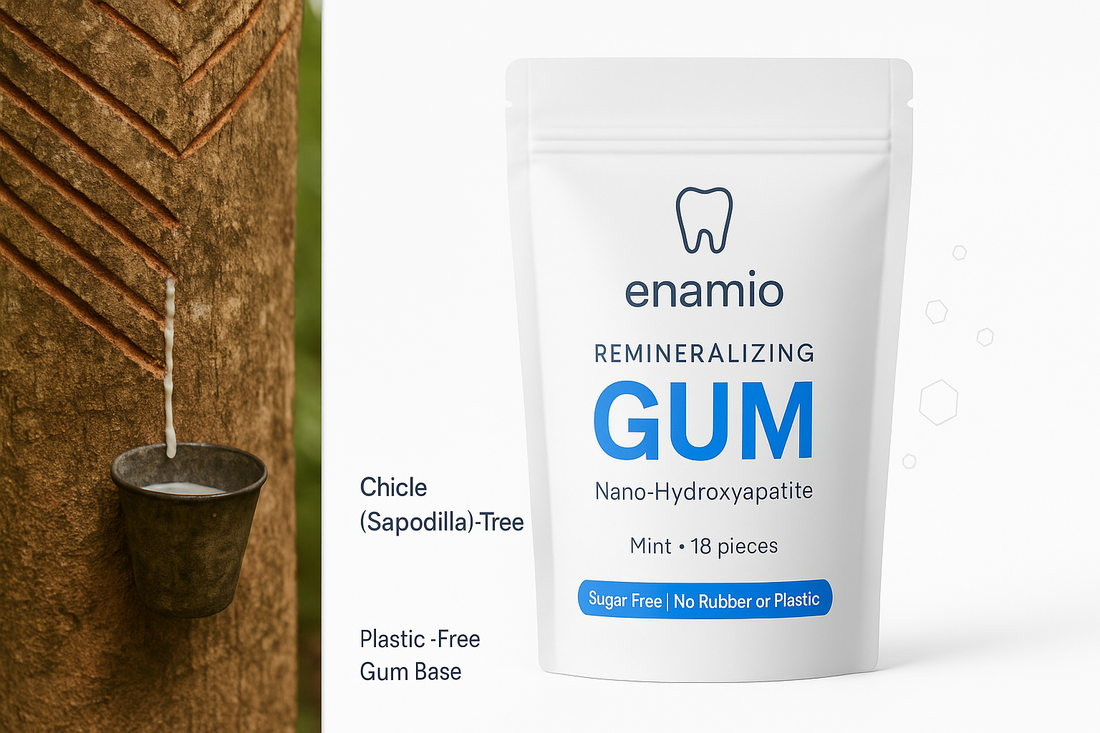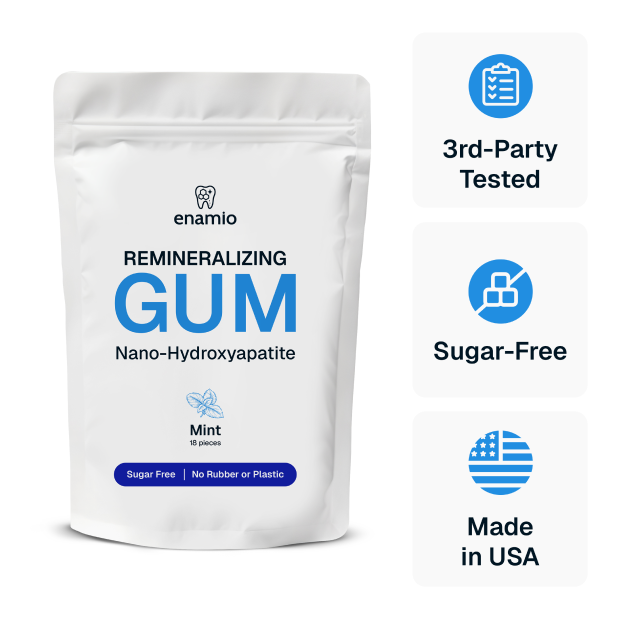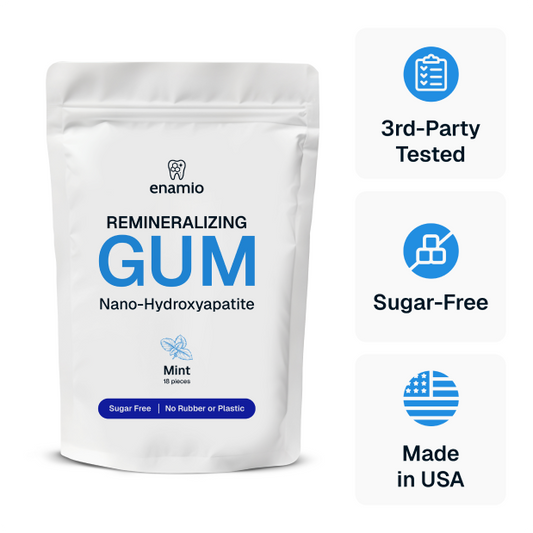
Chewing Gum Chicle Tree: Natural Base + Enamel Benefits | Enamio
Share
Chewing Gum Chicle Tree: The Natural Base Behind Plastic‑Free Gum — and How It Can Support Stronger Enamel
Understand what the chewing gum chicle tree (sapodilla) actually provides, how chicle compares to synthetic gum bases, and why Enamio pairs a clean, plastic‑free base with nano‑hydroxyapatite and synergists for daily enamel support.

Key takeaways
- Chicle is a natural latex tapped from the sapodilla tree (Manilkara zapota) and was the original chewing‑gum base; it’s plastic‑free and biodegradable (see Rainforest Alliance).
- Most modern gums use synthetic “gum base” materials legally permitted under 21 CFR §172.615; chicle is the plant‑based alternative.
- Chewing sugar‑free gum after meals boosts saliva and helps plaque pH recover—favorable conditions for enamel (see the American Dental Association).
- Enamio elevates chicle with a science stack: ~20 nm nano‑hydroxyapatite + calcium glycerophosphate + L‑arginine (ADS) + xylitol USP + matcha extract, with magnesium, zinc, and bamboo silica for support. See our full ingredient list.
First time here? Start with the science of nano‑hydroxyapatite gum.
Contents
If you searched for chewing gum chicle tree, you’re probably weighing plastic‑free chicle against “gum base” on mainstream labels—and wondering whether a natural base can also help your teeth. The short answer: yes, when that base is paired with modern remineralizing actives that work during the post‑meal saliva window.
The Problem: Most gum uses synthetic bases; chicle doesn’t
Conventional “gum base” is a legal umbrella that can include polymers (like polyvinyl acetate), elastomers, resins, and waxes that create chew and elasticity. It’s permitted under 21 CFR §172.615. While effective for texture, it isn’t plant‑derived and may persist in the environment longer than a tree‑sap base.
By contrast, chicle is the natural latex from the Manilkara zapota (sapodilla) tree. Tapped much like rubber and gently cooked into gum blocks, chicle offers a plastic‑free, biodegradable base with a heritage that predates modern synthetics (see the Rainforest Alliance sapodilla profile).
But “natural” alone won’t strengthen enamel. You need the right actives riding along while you chew—delivering biomimetic minerals and nudging pH in a favorable direction.
The Science: Why chewing + minerals is a powerful combo
Chewing after meals increases salivary flow and buffering capacity, helping plaque pH recover—conditions associated with less demineralization pressure (see ADA overview).
- Nano‑hydroxyapatite (n‑HA) — an enamel‑identical mineral — can fill micro‑defects and support remineralization of early lesions. Adult trials suggest HAp pastes can be non‑inferior to 1450 ppm fluoride for caries prevention (e.g., Paszynska 2023 RCT; broader review of n‑HA).
- L‑Arginine (ADS) fuels ammonia production by commensal bacteria, helping stabilize plaque pH in a more neutral range (see NIH‑hosted reviews).
- Calcium glycerophosphate (CaGP) supplies soluble Ca/PO₄ during pH rebound—useful co‑nutrition for crystal repair noted across enamel studies/reviews.
- Xylitol USP is non‑fermentable and associated with reductions in acidogenic biofilm activity when used consistently in gum formats (summarized by the ADA).
- Matcha/green‑tea catechins show adjunct antimicrobial/biofilm effects (e.g., Zeng 2022), complementing mineral delivery.
How Enamio Works: chicle base + ~20 nm n‑HA + CaGP + Arginine (ADS) + Xylitol + Matcha
Enamio starts with a natural chicle/candelilla base (no synthetic rubber or plastics). During the post‑meal window, chewing increases saliva, which helps distribute our ~20 nm nano‑hydroxyapatite (biomimetic mineral) alongside calcium glycerophosphate for ion supply. L‑arginine (as bicarbonate) supports plaque alkalinity (ADS), xylitol USP keeps the system sugar‑free, and gentle matcha catechins act as biofilm adjuncts. Supportive minerals (magnesium, zinc) and bamboo silica round out the stack. See the full ingredient explanation.
Strengthen Your Enamel, Anytime
Plastic‑free chicle base + ~20 nm n‑HA + CaGP + arginine + xylitol + matcha + zinc.
Buy Enamio GumHow to use Enamio (simple protocols that fit real life)
Daily protocol: Chew 1 piece for 15–20 minutes after meals or acidic drinks, 2–3×/day, for at least 8–12 weeks. Don’t rinse immediately after—let minerals linger before you brush later.
- Best windows: after breakfast coffee/citrus; lunch; mid‑afternoon snack time.
- Pair with a quality n‑HA or fluoride toothpaste and daily interdental cleaning. Gum complements, not replaces, standard care.
- For sensitivity: consistency over weeks matters more than single sessions (see n‑HA Playbook).
- Keep xylitol products away from pets.
From chicle tree to chew: the clean‑base pipeline
| Step | What happens | Why it matters |
|---|---|---|
| Sustainable tapping | Chicleros tap sapodilla trees; latex is collected and filtered. | Supports forest livelihoods; preserves trees (Rainforest Alliance). |
| Base formation | Latex is gently boiled into natural gum blocks. | Plant‑based, biodegradable foundation for chewing. |
| Active stack | Chicle is blended with n‑HA, CaGP, arginine, xylitol, matcha, zinc, magnesium, bamboo silica. | Transforms a clean chew into targeted enamel support. |
| Post‑meal use | Chew 15–20 minutes while pH recovers and saliva peaks. | Maximizes contact time for minerals at the enamel surface. |
Enamio vs competitors (chicle & non‑chicle)
Most “natural” gums stop at being plastic‑free. Fewer add a complete, evidence‑aligned mineral stack. Here’s a concise, mechanism‑first comparison (September 2025; always verify current labels):
| Brand | Base / Sweetener | Key active(s) | Mechanism & evidence | Practical benefit |
|---|---|---|---|---|
| Enamio | Chicle/candelilla; xylitol + monk fruit | ~20 nm n‑HA; CaGP; arginine (ADS); Mg; Zn; matcha; bamboo silica | Biomimetic mineral + ion donors + pH support + adjunct polyphenols. See full formula and n‑HA science. | Plastic‑free chew with a complete enamel stack. |
| Nathan & Sons Underbrush | Tree‑sap blend; xylitol/erythritol | n‑HA positioning; botanical resins | Mineral narrative; verify particle size/concentration on label. | Plastic‑free base with remineralizing positioning. |
| Refresh Gum | Chicle; xylitol/stevia | Matcha, mint; no n‑HA disclosed | Adjunct polyphenols; saliva/pH benefits of sugar‑free gum. | Clean chew; not a mineral‑stack product. |
| Simply Gum | Chicle; cane sugar or xylitol SKUs | No n‑HA disclosed | Plastic‑free base; freshness focus. | Natural chew; check sugar content by SKU. |
| Glee Gum | Chicle; cane sugar or xylitol SKUs | No n‑HA disclosed | Plastic‑free base; classic gum format. | Eco story; not formulated for remineralization. |
| True Gum | Chicle; sugar‑free | No n‑HA disclosed | Plant‑based; saliva benefits of sugar‑free gum. | Sustainability forward; limited enamel actives. |
| Spry | Generic “gum base”; xylitol | Xylitol only | Saliva/pH support without mineral donors. | Budget xylitol gum; base not chicle. |
| PUR | Generic “gum base”; xylitol | Xylitol only | Freshness and sugar‑free benefits. | Aspartame‑free; not a mineral‑stack formula. |
People also ask
What is the “chewing gum chicle tree”? The sapodilla tree (Manilkara zapota)—its latex (chicle) is boiled into a natural, plastic‑free gum base.
Is chicle gum biodegradable? Yes. It’s plant‑derived latex and used as a plastic‑free alternative to conventional gum bases; dispose of gum properly to avoid litter.
Does sugar‑free chicle gum help teeth? Chewing sugar‑free gum boosts saliva and pH recovery; with n‑HA and CaGP, it also supplies building blocks for early enamel repair (it does not replace brushing/flossing).
Is nano‑hydroxyapatite safe? Reviews and trials support HAp/n‑HA in oral‑care formats; adult RCTs show non‑inferiority vs 1450 ppm fluoride for caries prevention (see Paszynska 2023 and comprehensive review).
Is xylitol enough by itself? Xylitol helps with saliva and biofilm ecology, but it doesn’t supply Ca/PO₄. Pairing with n‑HA + CaGP targets the mineral side directly.
FAQs
Is chicle the same as “gum base” on labels?
Can a chicle gum fix cavities?
Is chicle safe if I have a latex allergy?
Why choose Enamio over other chicle gums?
Reading next
- Nano‑hydroxyapatite gum: the science‑backed way — mechanisms, particle size, and protocols.
- Rod‑shaped n‑HA guide — ingredients, evidence & why morphology matters.
- Hydroxyapatite gum brands (2025) — transparent competitor roundup.
- Is n‑HA safe in gum? — comprehensive safety review.
- Remineralizing gum 2025 — science, ingredients & usage.
Educational only; not medical advice. Always consult your dental professional for personal recommendations.
References
- 21 CFR §172.615 — Chewing gum base (U.S. eCFR)
- American Dental Association — Chewing Gum (topic overview)
- Rainforest Alliance — Sapodilla (chicle) species profile
- Paszynska E. et al. (2023) Hydroxyapatite vs fluoride, 18‑month adult RCT
- Pushpalatha C. et al. Nanohydroxyapatite in dentistry — comprehensive review
- Zeng J. et al. (2022) Green‑tea polyphenols as adjunct in oral care
- Enamio — complete ingredient list & benefits


